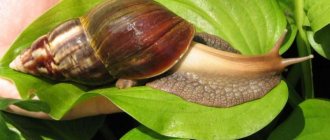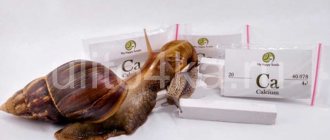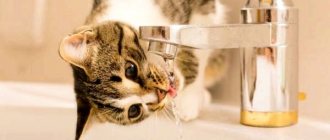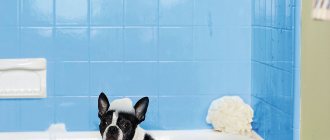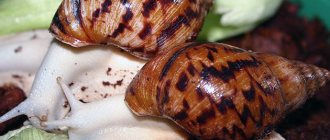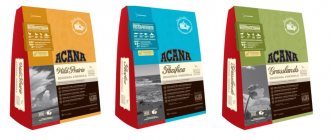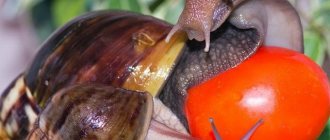Achatina snails: care and maintenance
Before talking about the content, let's touch on the issues of the benefits and harms of Achatina, which are simultaneously present when using snails for cosmetic procedures.
The mucus they produce really helps fight expression lines, rejuvenates, and tightens the skin. To do this, you need to put the snail on your face and let it crawl.
Achatina snail
For the sake of beauty, women are ready for such procedures. And here the harm of the mollusk becomes clear, which lies in the fact that lovers of smooth skin may develop an allergic reaction to Achatina mucus. When carrying out such a procedure for the first time, you should not put the snail immediately on your face, you need to let it crawl, for example, along your wrist, and then observe for a couple of days to see if an allergic rash appears. Also, Achatina mucus can cause infection if there are wounds on the skin.
In addition, in tropical countries, where this snail comes from, it destroys sugar cane and other agricultural plants, which again becomes harmful to humans.
African women's place of residence
These are land snails, so to keep them at home they need a house, which can be a terrarium or a large plastic container. You need to choose them by size depending on how many snails you want to keep. One Achatina needs a volume of 10 liters.
Basic requirements for the house:
- Must be rectangular, never round.
- The walls should be transparent or matte.
- A lid is required, otherwise the Achatina will spread.
- Do not use a plywood box or cardboard box.
- Must be made of safe materials (glass, food-grade plastic).
A terrarium is the best option. It is already equipped with a lid, has holes for ventilation, and everything is thought out for attaching a thermometer and accessories. The terrarium should be low so that the snail does not break if it falls from the ceiling. The main disadvantage of the terrarium is the high price.
A large plastic container is also a very good housing option for snails. There are a huge number of them sold in stores and in different sizes, so you can easily choose a container of the desired size. They all already have a lid, and it’s very easy to make ventilation holes in the plastic. These containers are inexpensive
When purchasing, you need to pay attention that the container is made of food-grade plastic. This house is very easy to wash and carry
To observe the life of snails, you just need to remove the lid, but then you must remember to close it.
A rectangular aquarium is also suitable, but you will definitely have to drill ventilation holes in its walls, and the glass may not withstand this and may crack. This is the worst option for a house for Achatina, as it is too heavy and fragile for regular washing.
House snail Achatina
Habitat
Achatina snails need soil; they cannot live without it. Snails lay eggs in the soil and sleep. It will also prevent the Achatina from breaking if they crawl onto the lid and fall down.
Depending on the size of the snail, add a layer of soil of 2-10 cm so that it can hide in it.
Suitable soil:
- Coconut substrate is cheap and does not stain the snails.
- Peat is cheap, retains moisture, but it is better to use it in a mixture with another type of soil.
- Moss is a free bedding that you can collect yourself; the snails will always be clean in it.
- Universal soil for indoor plants - holds moisture well.
- Leaf litter can be used as an independent soil or as an admixture. Achatina loves to burrow into it.
It is strictly forbidden to use:
- Sawdust is dangerous to the health of snails.
- Stones - because of them, snails break when falling from the ceiling.
- Sand - clogs the Achatina’s food system, which leads to death.
Stones
How to care for Achatina
If you want large snails to live in your home, caring for them should be as follows:
The soil should be irrigated daily with warm filtered water. Humidity is maintained at 60-70%, but the soil should not turn into mud
The humidity level is controlled with a hygrometer. If you do not need young Achatina, the soil is checked weekly for the presence of clutches and they are removed. Every week you need to wash the Achatina house with water without detergents and pour new soil into it, which must be immediately moistened.
You need to handle snails carefully. They should not be dropped or squeezed too hard.
Do not touch them with your hands if they contain residues of cream, soap or other cosmetics.
How fast do Achatina grow? Newborn babies are only 3-5 mm long. In the first month of life they grow up to 1 cm, by six months they will be 3.5 cm or a little more. Achatina grows all its life, but the main growth spurt will be in the first two years. Snails will grow only with good feeding and care.
Humidity and rules for bathing an African snail
The layer of soil in the terrarium should be at least 7-10 cm so that the snail can easily burrow into it.
Achatina does not need extra light; on the contrary, she prefers dark and secluded places. To maintain humidity, spray warm boiled water daily on the walls and soil of the terrarium. The substrate should be damp, but do not allow it to become waterlogged. The Achatina snail grows and develops well on coconut substrate, sphagnum moss or leaf litter. You should bathe your snail no more than 1-2 times a week. Bathing is a pleasant and interesting procedure not only for your pet, but also for you. Warm water activates the vital functions of the body. It is strictly forbidden to wash the snail under running water. How to properly bathe a clam. You should bathe Achatina in a shallow bowl with warm, but not hot water. After the water procedure, the snail shell should be wiped with natural vegetable oil.
See more similar articles:
How to choose an aquarium for keeping the Achatina snail:...
Terrarium for the Achatina snail - rules and examples...
Back Forward 1 of 16
How do Achatina snails reproduce?
If you are the owner of such fascinating pets as snails, you certainly need to know everything about their reproductive function. Most snail species breed easily in captivity, however, there are some factors to consider. How Achatina snails reproduce in their natural habitat and at home will be discussed in our article. Before you start breeding Achatina at home, you need to weigh and think about everything again. Since the snail grows at a slower rate during pregnancy, or its growth may stop altogether. This is due to the fact that the mother snail gives all the calcium to her babies, who need it to form the shells of their eggs, as well as the shells of their babies. Therefore, if you want to grow your pet to a large size, it is better not to refrain from mating the mollusk.
If you are still wondering how Achatina snails reproduce and want to see their babies, you should immediately think about where you will put the young individuals, the spread of which is not such an easy task. After all, the number of babies that can be born is in the hundreds! To prevent offspring from appearing unexpectedly, snails should be kept in different aquariums so that they do not have access to each other.
We draw conclusions: why do we need snails at home?
These animals embody slowness and passivity in its purest form. From them you can learn to avoid fuss and be a little slower, calmer, and more detached in the cycle of daily affairs.
This “beast” will be an excellent companion for not the most responsible owners. He will eat almost everything you cook, will fall asleep during your vacation, will not demand to play in the middle of the night and ask to go to the toilet early in the morning. It will brighten up your life without requiring constant attention and care.
Once you meet the Achatina, you will become friends for many years.
What and how to feed Achatina Reticulata
Achatina is predominantly a herbivore. Its main diet consists of vegetables and fruits, greens.
Reticulata are also fed with a mixture of different cereals, grain flakes and bran; they are an excellent source of vegetable protein. For normal development and growth, the mollusk also needs animal protein - dried gammarus and daphnia, bone meal and food for aquarium fish. The snail is given protein both in its pure form and in the form of a mixture of several products ground in a coffee grinder. They pamper their pets with various delicacies. Products containing calcium are also necessary for the health of Achatina. Its sources are sepia, food chalk, eggshells, and shell rock.
What to feed small Achatina reticulata snails
Newborn reticulates are fed lettuce or cabbage leaves, generously sprinkled with ground eggshells or chalk. Over the course of several days, they eat the remains of their own egg shell. At the same time, they are given grated vegetables and grain supplements.
A month after birth, young Achatina are fed in the same way as adults. This type of Achatina has a good appetite and rapid growth. Read more about feeding babies here.
Properly formulated diet for snails
The diet of Achatina must contain four main elements
- fruits;
- vegetables;
- herbs;
- calcium;
- protein.
Give food, water, protein and calcium supplements to the snail in a bowl or on lettuce leaves.
Ripe, raw and juicy fruits, vegetables and herbs are the main products for the Achatina snail. Calcium is the main building material needed for your pet. It is needed for the growth and formation of a healthy and beautiful shell.
Achatina needs calcium throughout its life. Feeding recipes for rapid growth. Protein is needed by clams for weight gain and rapid growth. Your task is to balance the snail's daily menu so that it grows strong and healthy. Do not forget to give Achatina clean water every day. It is better to feed the mollusk in the evening, as they are nocturnal. You should not put a lot of food, as in the humid and warm environment of the terrarium the food quickly disappears.
Reproduction at home
Achatina belongs to the category of hermaphrodite animals, therefore they have both male and female reproductive organs for reproduction. The total duration of the incubation period ranges from 28 to 56 days, which depends on the species characteristics of the gastropods, as well as the conditions of their home keeping. It should be noted that Achatina are extremely prolific, so many owners, in order to curb uncontrolled reproduction, simply wash off the excess egg laying that appears.
To obtain healthy offspring, you need to remember that during the incubation period, all cleaning activities are carried out with extreme care, and increased attention should be paid to monitoring and stabilizing air humidity levels inside the terrarium. After birth, all newborn snails are separated from the adults.
Instead of a substrate in your home, it is best to use lettuce leaves. The smallest Achatina are fed liquid porridge with the addition of grated carrots, which helps strengthen their shell and also very well activates growth processes. Among other things, it is necessary to remember that until the age of one and a half years, domestic gastropods should not be allowed to breed.
Preparing a terrarium for the Achatina snail
It is not necessary to buy a special terrarium for Achatina, since it can be made from an ordinary aquarium
It is important to consider volume. There should be at least 10 liters per snail
The home should be protected with a lid, as the snail can crawl out. For better ventilation, holes must be provided in the coating. As a last resort, you can simply lift the lid to create a small gap.
At the bottom of the aquarium you need to place pieces of wood (hard to rot), moss, and fragments of clay pots. This will serve as a shelter for the snail during the daytime. You can plant living plants inside the terrarium. The most unpretentious species are fern and ivy. They not only look beautiful, but also purify the air and create a natural microclimate. However, in this case, the substrate should not be allowed to become waterlogged.
When arranging a terrarium, you need to provide a small container with water, because Achatina loves to swim. As it becomes dirty, it will need to be changed. As a rule, this happens every 5-7 days.
The location for the terrarium can be anywhere. The main thing is that there are no heating devices nearby, as this will create an unacceptable temperature contrast. For the same reason, you need to keep Achatina’s housing away from windows so that direct sunlight does not fall on it.
What not to do
It is forbidden:
- Place the terrarium near a radiator or heater. The distance from the device should be at least 50 cm (or more, depending on the temperature of the radiator).
- Try to warm the house with an incandescent lamp aimed directly at the house or the snail. Bright light, as well as direct sunlight, are harmful to Achatina. Snails are very sensitive to bright light and it is not comfortable for them. The snail should live in a shaded house.
These simple recommendations will help you create a favorable climate in your snail's house and keep your pet healthy.
WHAT TO FEED YOUR PET?
These mollusks eat almost everything, but the basis of the diet should be plant foods. These are apples, watermelon rinds, cucumbers, zucchini, bananas, lettuce, berries, herbs, dandelions. They can be given pumpkin, tomatoes, peppers, spinach, broccoli, celery, mushrooms, milk, peanuts, beans and bread. In order to diversify the diet, you can offer the snail protein foods - eggs, poultry.
The snail needs calcium to grow its shell, so you need to place natural chalk or eggshells in the aquarium.
As nocturnal animals, snails eat at night, so it is better to feed them after lunch - so that the food does not stagnate in the heat.
Achatina are very picky eaters - despite the fact that they can eat almost anything, cucumbers most often become their favorite food, and they refuse to eat anything else. It is advisable not to pamper the snail and not let it switch to one product, as this may cause inconvenience in feeding.
Soft, spreadable and rotting foods (such as banana) should be given only briefly, and if they are not eaten overnight, they should be removed to prevent rotting.
Adsense clicker for making money on Google AdSense from 500 to 1000 dollars per month
It is strictly forbidden to give the snail food from the table - pasta, leftover fried, smoked, salted foods.
What to feed Achatina snails?
Achatina are not picky creatures. You don’t even have to feed them for 2-3 weeks, but in this case the snail will go into suspended animation (a state in which life processes slow down).
What do Achatina eat:
- Apples.
- Pears.
- Apricots.
- Grape.
- Melon.
- Bananas.
- Watermelon.
- Papaya.
- Avocado.
- Pineapples.
- Cherries.
- Cucumbers.
- Tomatoes.
- Carrot.
- Corn.
- Dill.
- Parsley.
- Spinach.
- Celery.
- Dandelion leaves.
- Bread.
- Milk.
- Hercules.
- Boiled eggs.
- Chopped nuts.
To improve the color of the shell, Achatina is fed with carrots, pumpkin, sweet peppers, tomatoes, nettle and plantain leaves.
What to feed Achatina
The main food of snails is plant food. They enjoy eating apples, lettuce and cucumbers. In the summer, clover, dandelions, and foliage should be added to the diet. Bananas, pumpkin, corn, zucchini, carrots - all this can be safely offered to the snail. Sometimes you can treat your pet with bran and oatmeal for variety.
Achatina needs calcium vitally. Make sure there is always chalk or eggshells in your pet's terrarium. You can use mineral stones or limestone for these purposes. Young snails need to grow, so they should be fed daily; Food should be offered to pets in the late afternoon, as their peak activity occurs at night. Adult Achatina feel great if they are offered food once every two to three days.
It is believed that watching Achatina perfectly calms the nerves. Since their conditioned reflexes are well developed, these pets can be easily trained. This is how the snails show signs that they have recognized their owner.
With proper care, Achatina can be your faithful friends for up to 10 years! You can purchase everything you need to keep Achatina at home in the Zoogalereya retail chain.
Feeding the snail
The diet of a domestic snail includes any fruits and vegetables (except citrus fruits), greens, small daphnia crustaceans, bread and even milk. To build a shell, they need calcium, which means there should always be chalk or cuttlefish shell in the terrarium. You can also sprinkle the soil with eggshells ground in a coffee grinder. Snails should not eat salt, sugar, spicy or fatty foods. It is not recommended to give small snails loose fruits; there have been cases when snails flew away with their heads buried in a banana and suffocated.
How do aquarium snails reproduce?
Both small and large aquarium snails can be either dioecious or hermaphrodite. With the first case everything is clear. Usually snails are purchased immediately in a bunch, and further reproduction does not present any problems. The second species can be reborn if the balance of the sexes in the aquarium is disturbed. Moreover, any snail can constantly bring eggs, once fertilized.
Heterogeneous snails
The caviar (eggs) of snails are so small that they blend into the surrounding background and sometimes it can be difficult to notice the future formidable army. Gastropods multiply exponentially, and one day you will find that the molluscs have become the dominant race in the aquarium.
Snail eggs on aquarium glass
Overdoing it with snails can lead to undesirable consequences:
- Water pollution. Although the slow movers clean the jar, they themselves pollute it. Their urea has a detrimental effect on both the fish and themselves. As a result, the snails die, and this causes even more trouble.
- Emergency situations. Yes, yes, it is a snail that can destroy your expensive filter. In search of food, it can easily be carried to the wrong place. And they can also gnaw clean the plants that you planted with such love.
Snail metropolis
It is clear that the emergency situation must be dealt with. How? Read on.
Conditions of detention
Some owners claim that snails become attached to their owners after prolonged contact, and simply will not “communicate” with people who are strangers to their pet. A tame snail does not hide in its protective shell out of fear and allows its owner to stroke it and pick it up. The largest Achatina snails (Achatina reticulata) are considered to be the most sociable and not shy representatives of this species. In order to ensure proper care, you will definitely need a terrarium. In extreme cases, you can use another non-toxic container with a lid and a hole for ventilation. In addition to the snail container, you will also need:
- Priming. A good option would be to use moss or coconut substrate.
- You will definitely need several plates for food.
- You need to monitor the current temperature in the terrarium using a thermometer. And to control the humidity level, use a hydrometer.
- Although pet snails do not require daily care, you will need a sponge to clean your pet's shell.
- Spray bottle filled with clean, settled water.
Note! Under no circumstances should the sponge come into contact with detergents.
In their natural habitat, snails prefer a subtropical climate. This suggests that in a home terrarium you also need to adhere to certain temperatures that are closest to the described conditions.
One of the main criteria for the comfortable life of any snail is the required humidity coefficient. In the terrarium, this factor is achieved through daily spraying procedures with filtered water using a spray bottle and is maintained due to the presence of soil and a pool. The humidity in the terrarium should be between 75 and 90%. If the snail lacks moisture, then some changes occur in its activity. Interest in food also disappears, and the snail itself may be completely or partially submerged in the ground.
Temperature in the terrarium at Achatina
Comfortable temperature in the terrarium ranges between 23 and 29 degrees with the required air humidity.
The most optimal range is 25-28 degrees.
It is undesirable for the temperature to drop below 20 degrees Celsius.
Temperatures of 18 degrees and below are considered dangerous. At this temperature, the snail can hibernate, which is not typical for this species.
The Achatina snail should not hibernate!
The Achatina snail hibernates under the influence of stressful, dangerous, and destructive factors. Hibernation is a forced mechanism, a way of survival, and not a normal seasonal process like in some other animals (hedgehogs, some species of bats, and so on).
Bringing a snail out of hibernation is quite difficult. In addition, if exposed to low temperatures for a long time, the animal may die.
In fact, maintaining the specified temperature is quite simple, because this temperature range is comfortable for humans. It is unlikely that the air temperature in your apartment is much lower or higher than the indicated 23-28 degrees.
Neretina horned snail species
There are more than 20 types of neretin. We will describe the species that are most often found in aquariums:
Zebra horned snail
The Zebra horned snail is popular on the southern coast of Africa. They differ from ordinary Neretina in color, size, and lifespan. The average lifespan is up to 2-3 years. The size of this snail is up to 2-3 cm.
It feeds on plaque on the walls of the aquarium and on decorations. If the aquarium is clean, then the snail needs to be fed with specialized food, spirulina.
Temperature for keeping from +22-25° C, acidity from 7-8.8 pH, hardness from 6-20° dH.
In particular, its tendency to “escape” can be attributed: this species most often disappears from the aquarium.
Neretina tiger snail
The tiger snail is a good assistant in the aquarium - a cleaner. Habitat in nature in southeast Asia, found on the Pacific islands. It reaches a size of up to 2.5 cm, but it happens that it grows up to 3.5 cm. Life expectancy is 2-3 years. Just like brindles, they often “run away”.
It feeds on plaque in the aquarium, if the aquarium is clean, the Tiger snail needs to be fed with spirulina, cucumber, blanched spinach, and cabbage. Feeding protein or food that contains a lot of protein may harm the snail.
Temperature for keeping in an aquarium is from +22-26° C, acidity is from 6.5-8 pH, hardness is from 8-12° dH.
Olive snail Neretina
The olive snail Neretina is slightly smaller than its fellows, 1-2 cm. Life span is from 3 to 5 years. The color of this snail is rich, dark olive color. It lives on the shores of Japan, China, and Indonesia.
Red-spotted Neretina snail
The red-spotted Neretina snail is popular on the shores of Africa. This type of snail is the most delicate and needs to be looked after carefully. Grows up to 2-2.5 cm.
They feed on plaque in the aquarium, if the aquarium is clean, eat dry fish food or specialized food for snails.
To maintain an aquarium, you need a temperature of 28-30° C. Their shell is very sensitive to acidity, which should not be between 7-8.8 pH. If the acidity is higher, the shell will collapse, resulting in the mollusk dying. Water hardness is from 9-35° dH. They often “run away”. Lives up to 3 years.
Solar horned snail or Beeline horned Neretina snail
The size of the Beeline snail is up to 1.5-2 cm. The name Beeline was given to it by Russian aquarists due to the similarity of the color of the snail with the logo of a famous Russian operator.
This species is the best for cleaning an aquarium - they carefully eat algae without touching living and young plants. May crawl out of the aquarium due to improper maintenance
The main diet of the aquarium is algae deposits on the walls of the aquarium and decorations. When the aquarium is clean, the horned snail Neretina Solnechnaya or the Beeline snail are in danger of starvation. To avoid starvation, the snail needs to be fed with specialized pressed algae for snails or fish.
To maintain it, the water temperature must be from +22-27° C, the acidity of the water is from 7.2-8.2 pH, the water hardness is from 10-13° dH. The lifespan in an aquarium is 3-5 years.
What to pay attention to
African giant Achatinas do not die like aquarium fish, turning over with their belly up. They can struggle for a long time to exist without showing external visible signs.
Achatina, like other species of gastropods, has a remarkable property. Under unfavorable conditions, gentle creatures hibernate. However, this does not mean that the snail is dead.
Unfavorable maintenance factors can cause the snail to not crawl out of its shell. If they are not corrected, this can cause the death of Achatina.
How the last representative of a valuable snail species died - read on.
First of all, these are low temperatures, a lack of vital elements in the diet and the general malaise of Achatina. Perhaps a sick snail is not sick or dying, but simply stressed! She reacts negatively to changes in environment and other unfavorable factors; she needs adaptation and restoration of vitality. In this case, the Achatina will close its lid and burrow into the ground and can remain in this state for 1-2 weeks. These are alarming signs that can lead to the death of Achatina.
If you encounter this situation, it does not mean that your snail is dying. Create favorable conditions in the terrarium. Tempt the snail with its favorite foods. If after several days and attempts the snail remains sealed, try buying it in warm water. These simple manipulations help save a dying hive in 95% of cases.
Check whether your pet's home meets the required standards of size, ventilation and heating, soil quality and does not contain dangerous objects and substances.
We recommend purchasing high-quality terrariums, as well as soil, heating, humidifiers and decor on the Aliexpress website. This is proven quality and good prices.
How to understand that the Achatina snail is dying?
Only daily close observation of Achatina will provide accurate and reliable information. Every day in the evening, breeders renew the food supply, pour water into the drinking bowl and watch the slow-moving creatures in the terrarium.
A dying Achatina snail does not eat, drink, or respond to external stimuli. If an individual does not move for 2-3 days, does not react to the owner and to fresh food, then the pet has big problems and perhaps they can lead to his death.
Signs of death of the Achatina snail:
- The shell is sealed with film for a long time and the pet shows no signs of life.
- When Achatina is torn from the surface or touched, it instinctively retracts its head and leg. A weakened individual, close to death, does not exhibit characteristic natural reflexes.
- The main sign of death is that the dead Achatina snail has become sealed and stinks. If the sink smells like a rotten egg, this indicates the death of a defenseless pet.
After the loss of a beloved pet, the question always arises: could the dying snail be saved?
Russian and foreign breeders of African mollusks have already accumulated extensive experience in the proper care and rescue of Achatina snails
It is important to keep a close eye on the delicate creatures and take preventative measures as needed. Let's look at the main mistakes
What do snails need – No. 1 Terrarium
The ideal home for Achatina and Archatina snails would be an aquarium or terrarium with a volume of 10 liters or more; if there are more than two pets, then the volume should be at least 20 liters. Make sure that ventilation is organized correctly; for this, there should be holes in the lid and one of the walls for air ventilation.
If you decide to have a smaller snail at home - for example, an ordinary grape snail - then a simple kitchen container with a capacity of up to 5 liters will be suitable as a house for the snail.
Snails love to burrow, so the bottom of their home must be lined with a layer of moist substrate. Snails need to pass everything through themselves; they should absolutely not be used as soil: – clay; – rotting wood and pieces of bark; – flower soil – due to fertilizers, harmful substances will accumulate in the animal’s body, which can lead to premature death; – sawdust – fraught with splinters, scratches and inflammation; – nut shells – water is not absorbed into them, but accumulates at the bottom and provokes the appearance of harmless but unpleasant fruit flies; – sand – is not able to retain moisture, and will also injure the pet’s body, making the shell dull and scratched.
Composition of mucus and beneficial properties of the Achatina snail
The mucus of these creatures is used to treat a number of diseases and eliminate some cosmetic problems.
This largely explains the increased attention to creatures
It is necessary for the creatures themselves to protect the soles from abrasion and improve gliding on the surface. In addition, the secretion prevents the shellfish skin from drying out. Achatina mucus contains many useful substances, including:
- collagen;
- allantoin;
- lectins;
- elastin;
- vitamins A, E, B, C;
- peptides;
- glycolic acid.
Collagen helps maintain the firmness and elasticity of the skin. Elastin, which is part of mucus, also helps maintain the elasticity and smoothness of the skin. A component such as allantoin has a pronounced antioxidant effect, therefore it prevents the appearance of free radicals and helps to launch regeneration processes.
The vitamins contained in mucus can protect the skin from premature aging. Peptides have an antibacterial effect. Lectins and glycolic acid help cleanse the skin of impurities and dead cells.
Biologically active compounds present in the mucus of these creatures have the following effects:
- reduce expression wrinkles;
- rejuvenate the skin;
- lighten age spots;
- moisturize the dermis;
- smooth out scars;
- reduce the inflammatory process;
- helps eliminate acne.
This type of mollusk is often used in cosmetology to eliminate many skin imperfections. In addition, in folk medicine, the mucus of these creatures is used in the treatment of infectious diseases of the upper respiratory tract, eliminating signs of varicose veins and psoriasis. The mucus has a mild analgesic effect. In the regions where these creatures live, they are often eaten to treat and prevent diseases of the gastrointestinal tract and improve the functioning of the nervous system.
Achatina snails: benefits and harm to humans
Getting used to people, these pets stop being afraid of them
Achatina snails: benefits and harm - two sides of the same coin. The thing is that these creatures produce mucus, which is very useful for the human body, for sliding. It quickly heals wounds, smooths out scars, and also fights expression lines. If you want to apply the healing properties on yourself, you should first of all wash your pet thoroughly and only then use its saliva for cosmetic purposes.
The mollusk can also be dangerous, because... it is a carrier of various bacteria and, if washed poorly, it can cause infection in wounds on the skin. If ingested, an allergic reaction may develop.
Health, disease and prevention
The main causes of snail diseases are most often presented:
- improper maintenance, including hypothermia or overheating of the animal, the use of a terrarium that is too small, the use of dry or marshy soil;
- low-calorie diet with insufficient protein and calcium;
- rare cleaning of the terrarium, accumulation of rotting food debris and excrement;
- improper ventilation and poor-quality soil;
- disturbances in the neighborhood of different species and subspecies of domestic snails.
The main signs of the disease in a pet are lethargy, complete or partial refusal to eat, blockage of the entrance to the shell, excessive or thick mucous discharge, as well as pronounced delamination of the shell. Of particular danger is the loss of a gastropod from its shell, which can be caused by genetic predispositions or prolonged exposure to carcinogens, the influence of bacteria, infections and fungi. The result of this pathology, as a rule, is the rapid death of the snail. In order to prevent such diseases, it is recommended to competently approach the process of choosing basic feed and additives of animal origin.
Careless handling of domestic shellfish can cause household damage and damage to the integrity of the shell. Not too large damages are most often corrected with epoxy glue, after which the animal must be provided with a diet enriched with calcium.
Unsanitary conditions for keeping snails provoke the appearance of parasites and infectious diseases in your pet, which can sometimes be very difficult to get rid of. To treat the animal, it is allowed to use propolis-based ointment, as well as the drug “Mikoseptin” and a pharmaceutical solution of iodine.
Snail care
Most gastropods do not require complex care, but will not give up comfort and ideal living conditions. This will help protect them from disease and promote long life.
General rules
When caring for domestic snails, it is very important to know when to stop. Increased attention and care can only harm the mollusk and affect its health. Each individual species needs special care, but for all of them there are several general rules:
- Periodically you need to give your pets water treatments (if they live in a dry container). They consist of placing under a warm shower and regular spraying. In addition, you need to place a shallow bowl of water at the bottom of the container.
- It is important to clean the aquarium from all types of contaminants several times a month.
- Periodically you need to remove the old litter and replace it with a new one.
- If severe contamination is detected, it is necessary to carry out an extraordinary cleaning of the mollusk “house”.
Increased attention and care can only harm the mollusk and affect its health.
During winter, many species of snails can hibernate. This will only happen if the ambient temperature drops sharply and the humidity decreases significantly. In this state, the mollusk protects its shell with a special film and completely cuts itself off from the outside world. Experts recommend avoiding hibernation for too long (more than 2 months), as the snail may die.
For young individuals, this condition is especially harmful. They are actively developing, for which they need constant and regular nutrition. During suspended animation, the mollusk will not receive the required amount of nutrients and may get sick. To wake up an individual of any age, it is enough to bring it under a stream of warm water and hold it for several minutes.
https://youtube.com/watch?v=ljpTXslfNvA
Taking care of your sink
The main sign of the health of a mollusk is a beautiful shell. Based on its condition, you can determine not only the pet’s well-being, but also the type of disease. To prevent problems from arising, you need to carefully care for your sink. This is especially important for large species of snails.
Beginners should pay attention to the following points:
- If any damage to the shell is detected, you must immediately change your pet’s diet and include the maximum possible amount of foods containing calcium. This will help the snail recover faster and “repair” the damage.
- The same steps should be followed if delamination or brittleness occurs.
- If a shellfish is injured (a chip or large crack in the shell), it is necessary to immediately treat the damaged surface with an antiseptic. In addition, you need to place the sick individual in a separate aquarium so that it does not aggravate its injury.
The main sign of the health of a mollusk is a beautiful shell.
Disease Prevention
There are situations when, due to improper care or maintenance, the snail gets sick. This can be determined by her lethargic behavior, refusal to eat, shell separation, and strong mucous discharge. The cause of a pet's illness can be:
- Sudden temperature changes, as well as overheating or hypothermia.
- The tightness of the aquarium or terrarium.
- Using soil that is too dry or wet.
- Calcium or protein deficiency.
- Contamination of the container with food debris and waste products of the mollusk.
- Insufficient or incorrect ventilation.
- Neighborhood with other species.
To avoid troubles with your pet’s health, you need to carry out all care measures on time and feed the snail correctly. If left untreated, even the most innocuous crack in a sink can lead to serious illness or death.
Caring for indoor snails is a rather difficult undertaking that requires a significant investment of time and effort. With the right approach to business and following all the recommendations of professionals, you can create the most comfortable conditions for your pet. Thanks to this, he will be able to live a long life.
How and where to buy Achatina snail
Since African snails reproduce easily, you can buy them at a pet store, from breeders or in an online store. On Avito and OLKh they sometimes give away small Achatina snails for free, sending them by mail. Choose for yourself where to buy.
However, before purchasing a two-horned pet, look at its parents and all the livestock, so as not to buy a sick and problematic snail. You can become infected with worms from a sick African snail, because it does not suffer from them, but is a carrier. Therefore, do not rush to plant the “new” Achatina in a common terrarium, but keep it in quarantine for 2-3 days and carry out preventative measures. Before and after handling the snail, wash your hands thoroughly with warm water without soap.
Two years ago I was given a couple of African snails for my birthday; before that I didn’t even know about their existence. They and I spent several months getting used to each other and learning a lot. This is how my love for them began. Now Achatina is my ideal pet. And for you? Do you think Achatina is an ideal pet? Please leave your comment.
Selection and purchase of containers
The Achatina snail travels everywhere with its house. But for ease of maintenance, it requires a tank that meets certain requirements:
- A container that has a round shape is not suitable for the Achatina snail.
- The walls of the selected tank can only be transparent, matte.
- Containers made from plywood, wood or cardboard are not suitable for storage.
- The container is covered with a lid.
Terrarium
Achatina uses a terrarium as a house for a snail. Pet stores have both horizontal and vertical models. The first option is more preferable because it is less mobile. Therefore, such a container cannot fall.
When selecting a terrarium, focus on the material. For its preparation, no material should be used that includes toxic components or harmful substances.
A terrarium for the Achatina snail must be equipped with a lid. With the help of this element, the possibility of unauthorized movement of the mollusk is prevented. The container is supplemented with a thermometer, with which the temperature level is monitored.
Since the cost of a terrarium for Achatina is quite high, not all aquarists purchase it. The price of such a product fluctuates. Thus, when determining prices, manufacturers take into account the raw materials used for these purposes. For example, glass containers are inexpensive. But the structure is easily destroyed.
Aquarium
Square or rectangular aquariums are also used as a home for Achatina. Its volume is 20–40 liters. Such a tank is supplemented with a lid made of organic or ordinary glass. Technological holes are prepared in the covers.
Why doesn't everyone choose aquariums? There are several reasons:
- Considerable weight.
- Fragility.
- It is problematic to form technological holes.
Food containers
Such containers are prepared from raw materials that are considered environmentally friendly. It is equipped with a lid, so the snail will not be able to leave the house.
To complete such a tank, thermal mats and measuring units are used.
Experienced and novice aquarists create houses for mollusks with their own hands from a food container. In order to get the best result, you should familiarize yourself with the rules of arrangement.
What conditions are needed for maintenance?
At home, snails are most often kept in terrariums. But aquariums, plastic boxes for keeping rodents, and large plastic food containers are also suitable for these purposes. The main rule is that there must be a lid, otherwise the snail will easily escape. In this case, you must not forget about ensuring air access inside. Glass and plastic terrariums are easy to clean.
A very important point is the correct soil for Achatina. After all, it is necessary to remember that this land mollusk lays eggs in the ground, for which it buries itself in it for a while. Therefore, the thickness of the soil layer must be at least 5 cm, otherwise the snail simply will not be able to burrow into it. It’s worth warning right away that sawdust is not suitable for snails as soil. You can buy ready-made soil at a pet store. Or do it yourself. It is best to use a mixture of calcined sand, dry grape leaves and soft soil for these purposes.
Grape leaves are a delicacy for Achatina. If you live in a private house and you have grapes, stock up on dry leaves in the fall. You can pour them as soil without other impurities. Just “compact” it a little at the bottom to create the effect of a “hard” surface. Snails will happily eat such litter and easily bury themselves in it if necessary. Do not place large stones on the bottom of the terrarium under any circumstances! A large snail, crawling along the lid of a terrarium, can fall to the bottom under the weight of its own shell and damage it. This is dangerous to the health and life of the snail.
The temperature in the terrarium should not be lower than +24 degrees, otherwise the snail will become inactive and hibernate. In the cold season, to prevent the snail from hibernating, you can warm up the terrarium space using a backlight lamp. By the behavior of the snail you can understand whether the microclimate in the terrarium has been created correctly. If your pet spends more time crawling along the walls of the terrarium, this means that it is too humid. And if there is excessive dryness, the snail will “decide” that unfavorable times have come and it’s time to hibernate - it will “close itself” in its shell. In these cases, it is necessary to either dry the soil with a lamp or moisten it with a spray bottle.
For the purpose of reproduction, you can get 2-3 snails at once. By nature, they are hermaphrodites, so it is not useless to worry about the “right” gender of your pets. You will know that the “marriage” has taken place when one of the snails burrows into the ground for a while to lay eggs. If this happens too often, and you do not intend to bother with “identifying in good hands” small snails, you can take out the clutch and freeze it. And after defrosting, offer it as food to your snails. Snails never eat live clutches, but eat “dead” eggs with pleasure. They are useful as a source of calcium for shellfish.
On average, after two weeks, the eggs hatch into tiny Achatina, which grows right before our eyes. In growing snails, the body and shell itself are still transparent, and you can easily see the entire anatomy. It is very interesting to watch how these kids eat.
Achatina can be let out for a “walk” by laying out various leaves for them on a tray or table. The snail, which is often picked up, is not at all afraid of humans and does not hide in its shell. She studies any new surface with interest. But you shouldn’t leave snails “out for a walk” unattended for a long time. Despite the apparent slowness, when exploring the territory, Achatina can quite quickly “scatter” and get lost. Here is a real life case. A snail with a shell about 4 cm in size was released for a walk in the kitchen.
She walked on dandelion and plantain leaves laid out in a tray on the table. She was left unattended for half an hour. It wasn't on the tray. A search throughout the kitchen yielded no results. There was even a version that poor Achatina crawled onto the windowsill and fell out of the open window... Two months later, the owners and their guest were drinking tea in the kitchen. The guest went to the built-in sink to wash her hands. And suddenly she was very frightened by the appearance of an “unknown monster” from behind the shell. A person who had not seen Achatina before and saw a “monster” crawling out rather quickly did not immediately understand what it was.
The owners, delighted to see the snail, reassured the guest, explaining that it was just their long-lost pet. As it turned out later, when examining the snail’s temporary abode, it spent all this time quite well, eating wallpaper and plaster at the sink and kitchen table. And she has grown noticeably. Therefore, in order to prevent such incidents from happening, it is better to control your snail’s walks.
Types of soil for Achatina
Pet stores offer high-quality soil in the form of coconut substrate, peat and washed forest soil. You can prepare it yourself. To decide on the soil for your pets, you need to know the characteristics of the materials. And then make a choice in favor of one or the other.
Coconut soil is optimal for shellfish. It is commercially available in the form of briquettes: the dried block is soaked and converted into soil. This substrate will not stain the walls, retains moisture for a long time, and mold will not grow on it. But food for Achatina should not be placed on it. When using this type of substrate, food should be placed in a feeder or on a lettuce leaf.
Peat - a specially prepared substrate, from a pet store - is also a good option. Many owners of Achatina simply keep them on soils of different compositions from pavilions selling indoor plants. Or on soil collected from the forest. But in both options, such soil must be thoroughly poured with boiling water or fried in the oven. Peat retains moisture well. Moss and dry leaves are placed on top of it. In such soil, seeds of decorative terrarium plants germinate well and seedlings take root. Plants in the terrarium of African snails are not only interior decoration, but also food for these mollusks.
Sphagnum (one of the types of bog mosses) is also suitable for Achatina. It not only maintains humidity, but also plays the role of a barometer in the terrarium.
- If the sphagnum begins to dry, this means that the required level of humidity in the terrarium has decreased.
- If it turns green, everything is fine.
Moss does not need to be changed as often as other types of soil, and it looks aesthetically pleasing. The only “but” is that moss is not suitable for small Achatina, such a terrarium is not suitable for a large snail. Small individuals simply will not be able to bury themselves in such litter.
Keepers of snails do not like sand. On the one hand, these are African snails, sand is their habitat. On the other hand, sand does not retain moisture, sticks to the snail’s body and shell, and even scratches the walls of the terrarium. In addition, grains of sand clog the mollusk’s digestive system, which can lead to the early death of the pet.
Sawdust is an undesirable soil, since it practically does not absorb moisture, which is why it begins to stick together and rot. Their sharp edges can injure Achatina’s body. Breeders know that if a snail is kept on sawdust for a long time, its shell will become covered with a white, indelible coating.
It is strictly forbidden to keep Achatina on a rocky bottom - it is impossible to bury itself in gravel. A snail can also break its shell by falling from the wall to the bottom.
Health, disease and prevention
A number of factors influence the health of a snail, such as:
- Maintenance problems associated with hypothermia or overheating of shellfish. Confinement in cramped housing, using either dry or too wet soil.
- Nutritional problems when shellfish are fed low-calorie foods that contain insufficient amounts of protein and calcium.
- Problems with living conditions associated with unsanitary conditions.
- Poor ventilation and poor quality soil.
- Neighborhood problems when the compatibility of different species is not taken into account.
If a pet refuses food completely or partially, becomes lethargic, becomes clogged in the shell, and various discharges in the form of thick mucus are observed, then this is the first sign that the snail is sick. The disease is also indicated by delamination of the shell. The most dangerous disease is when a gastropod falls out of its shell. Such consequences may be associated either with genetic predispositions or as a result of prolonged exposure to chemically harmful components, bacteria, infections or fungi.
As a rule, in this case the mollusk quickly dies. To protect yourself and your pet from negative processes, you should approach dietary choices wisely.
In case of careless handling of the snail, damage of varying severity may occur, compromising the integrity of the shell. Some damage to the shell can be removed with epoxy glue, but in any case the animal must be provided with food rich in calcium
If you keep a snail in unsanitary conditions, it may develop parasites or infectious diseases, which require enormous effort to get rid of. To combat such phenomena, propolis-based ointments are used, as well as the drug “Mikoseptin” and iodine solution, which can be purchased at the pharmacy.
Reproduction
Snails are hermaphrodites, which means keeping two or more individuals in one terrarium can lead to their fertilization. The majority of these mollusks lay eggs, although viviparous species are also found. Basically, the snail buries its clutch in the ground, and it is advisable not to miss this moment, since the clutch is removed from the terrarium and carefully placed in a separate container.
In this case, it is necessary to maintain the same soil consistency and humidity where adult individuals live. Soon the small snails hatch and then crawl to the surface. The babies are completely ready for life and feed on the food that their parents eat, but until their shells get stronger, it is better not to put them with large snails.
